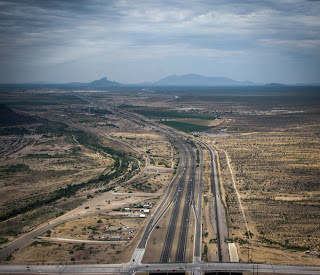At last, civilization! Or at least, what seems to be so when the basic criteria you apply is "has a taxi service".
We'd called ahead in our never ending quest for overnight hanger space and so the airport manager had kindly agreed to leave one side of the hanger open for us, but only with the strictest instructions about not blocking-in the air ambulance!
While waiting for the taxi to arrive to take us to a nearby hotel (we were only 5 miles outside of Blythe) I heard some odd engine notes in the background and went to see what was happening.
Taxi; hotel; Sizzler; bed. Another of those exciting on-the-road kind of nights, then! Honestly, by that stage, and remembering we'd just flown 8.7 hours for five legs, all in desert heat, all I cared about was air-conditioning and sleep.
07:00 and the sole taxi (same car, same driver) was back at the hotel, and we were soon back at Blythe airport. With luck and a final push, today should see us back at home base.
For the first leg, we aimed to do Blythe (BLH) to Barstow-Daggett (DAG). Working through it the night before, our best option this time was to follow an old railway line north west through the desert before picking up another road, this time Route 40, to take us straight to Barstow. With the early morning light filtering through some mid-level clouds, the desert & surrounding mountains looked beautiful as we flew across open territory.
Once again, Mother Nature was exceedingly kind to us. Not only was visibility excellent. but the winds were light and so we crossed the Sierra ridge-line with barely a ripple. Bakersfield was not far off, fuel looked good, and for the first time we caught sight of the Pacific.
We landed at L45 after 1.9 hours, found the self-serve 100LL and then - even better - we found the airport had a cafe (and a very nice one to boot!), albeit at the other end of the airfield. I have to say though, it felt slightly decadent firing 2SA up again just to taxi from the fuel pumps to the cafe, where we were delighted to find helipad markings on the apron out front; just 'cos, that's where we therefore parked!
Reviewing the charts, and based on the performance we'd measured to date, we had a shot at doing the remaining part of the trip in one shot - L45 to WVI. It would be tight fuel-wise, but do-able. And of course, since we were now on home turf, we had a good idea of places to get fuel along the way if needed. Therefore, that became the plan of record: head west; cross over the hills between I5 and Paso Robles; head north-west up 101 via King City, and from there it's a straight shot into the Monterey area and home.
Now, however, things changed a little. We picked up a 20 knot headwind and hence our speed dropped and fuel consumption rose. We got as far as Salinas (SNS) just as the auxiliary tank showed empty, a situation that ought to have left us with fuel for around 50 minutes flying. Bearing in mind a) we didn't have that much experience of 2SA's fuel gauge accuracy, b) we still had those pesky headwinds, c) by law we had to land with a minimum of 20 minutes fuel remaining, and d) as Wendy rightly pointed out, we now ran the risk of catching "get home-itis", we decided to set down in Salinas for a splash-and-dash at the helipad; we'd been after flying for 2.7 hours by this point.
An epic journey was now over, and so many thanks to all concerned for both giving me the opportunity to make it, and for helping us to do so safely. Yes, it was a tiring and, as my shoulder will attest, sometimes painful flight, but I'd do it all over again in a heartbeat!





















